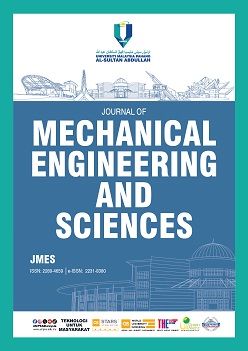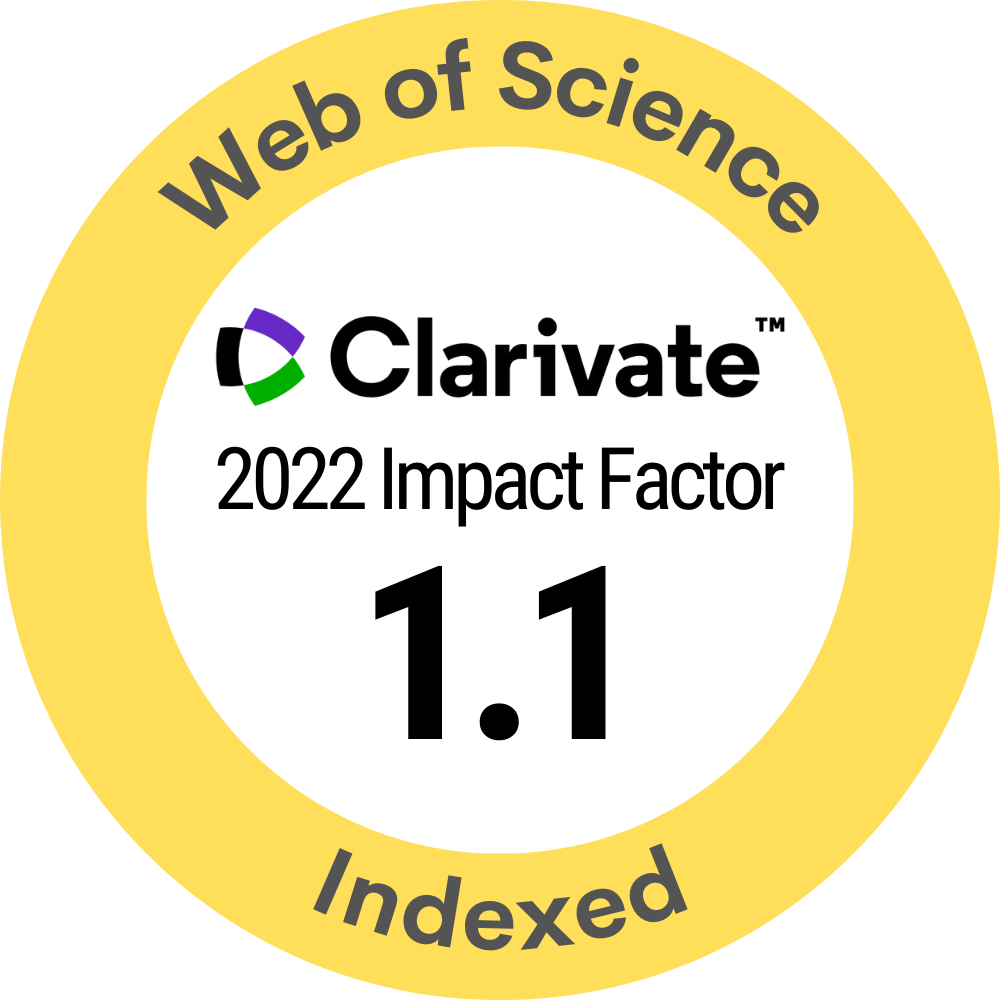Advancement of human-machine collaboration in manufacturing: A review on industry 1.0 - 6.0
DOI:
https://doi.org/10.15282/jmes.18.4.2024.7.0813Keywords:
Industrial revolution, Industry 1.0-6.0, Cyber-Physical Systems, Artificial Intelligence, Machine LearningAbstract
The industrial revolutions have significantly influenced global production and manufacturing strategies in recent times. This was made possible due to the pivotal function of emerging technologies such as cyber-physical systems, artificial intelligence, machine learning, and the internet of things. The integration of these technologies in Industry 4.0 facilitates the establishment of smart factories, distinguished by enhanced connection, automation, and data-driven decision-making. These systems have applied cyber-physical systems in real-time interaction between physical and computer processes while artificial intelligence and machine learning enhanced production via intelligent automation and predictive maintenance. Hence, this review offers a comprehensive examination of the conceptualization of historical revolutions from Industry 1.0 to 5.0 and a futuristic outlook for Industry 6.0. The findings indicate a transformative path in human-machine interaction that showcase seamless collaboration between humans and intelligent machines. The review revealed a progression that advanced unparalleled efficiency, adaptability and customization in manufacturing processes. Thus, the review highlights the transformation from automation-centric models to a human-centric approach. The possible present and future benefits for researchers, practitioners, and policymakers in advancing technology and manufacturing as well as future outlooks were enumerated. Hence, the socio-economic impact of these trends in revolution cannot be overemphasized and, therefore, require more attention. Conclusively, available and needed materials were noticed to be part of the driving force for industrial revolution in agreement with trends in material ages.
References
[1] S. O. Falana, D. O. Folorunso, I. O. Oladele, G. Mogbojuri, L. N. Onuh, “Comparative effect of woodflour and granulated rice husk on the thermal insulation of termite hill clay,” Journal of Chemical Technology and Metallurgy, vol. 59, no. 5, pp. 1093-1102, 2024.
[2] I. O. Oladele, A. D. Akinwekomi, J. G. Akinseye, S. O. Falana, S. R. Oke, “Evolution of bamboo derivative fiber-mollusk shell based calcite particulate hybrid reinforced epoxy bio-composites for sustainable applications,” Journal of Composite Materials, vol. 58, no. 24, pp. 2597–2622, 2024.
[3] H. T. Owoyemi, B. O. Adewuyi, I. O. Oladele, S. O. Falana, S. A. Oyegunna, J. O. Ajileye, “Silver nanoparticles reinforced polyethersulfone composite for sustainable application,” Discover Polymers, vol. 1, no. 4, pp. 1-21, 2024.
[4] I. O. Oladele, S. O. Adelani, B. A. Makinde-Isola, T. F. Omotosho, “Coconut/coir fibers, their composites and applications,” in The Textile Institute Book Series - Plant Fibers, their Composites, and Applications, pp. 181-208, 2022
[5] F. O. Olajesu, I. O. Oladele, T. F. Omotosho, F. A. Atilola, S. O. Adelani, “Influence of quartz and marble on the performance of particulate-filled rigid polyurethane foams,” Journal of Engineering and Technology, vol. 6, no. 1, pp. 8-25, 2024
[6] S. O. Adelani, I. O. Oladele I. Akinbamiyorin, A. Oyetunji, F.O. Olajesu, “Development of hybrid plantain fiber-calcite particles reinforced polyvinyl chloride biocomposites for automotive applications,” Journal of Thermoplastic Composite Materials, vol. 37, no. 6, pp. 1938-1956, 2024.
[7] B. A. Makinde-Isola, A. S. Taiwo, I. O. Oladele, A. D. Akinwekomi, S. O. Adelani, L. N. Onuh, “Development of sustainable and biodegradable materials: A review on banana and sisal fibre based polymer composites,” Journal of Thermoplastics Composite Materials, vol. 37, no. 4, pp. 1519-1539, 2024
[8] I. O. Oladele, T. F. Omotosho, G. S. Ogunwande, F. A. Owa, “A review on the philosophies for the advancement of polymer-based composites: Past, present and future perspective,” Applied Science and Engineering Progress, vol. 2021, pp. 1-27, 2021.
[9] K. A. Demir, G. Döven, B. Sezen, “Industry 5.0 and human-robot co-working,” Procedia Computer Science, vol. 158, pp. 688–695, 2019.
[10] F. Longo, A. Padovano, S. Umbrello, “Value-oriented and ethical technology engineering in Industry 5.0: A human-centric perspective for the design of the factory of the future,” Applied Sciences, vol. 10, no. 12, p. 4182, 2020.
[11] S. Nahavandi, “Industry 5.0: A Human-centric solution,” Sustainability, vol.11, no. 16, p. 4371, 2019.
[12] X. Xu, Y. Lu, B. Vogel-Heuser, L. Wang, “Industry 4.0 and Industry 5.0-Inception, conception and perception,” Journal of Manufacturing Systems, vol. 61, pp. 530–535, 2021.
[13] Y. Lu, H. Zheng, S. Chand, W. Xia, Z. Liu, X. Xu, et al., “Outlook on human-centric manufacturing towards Industry 5.0,” Journal of Manufacturing Systems, vol. 62, pp. 612–627, 2022.
[14] J. Vrana, R. Singh, “NDE 4.0—A design thinking perspective,” Journal of Nondestructive Evaluation, vol. 40, no. 8, pp. 1-24, 2021.
[15] M. Javaid, A. Haleem, R. P. Singh, R. Suman, “An integrated outlook of cyber–physical systems for Industry 4.0: Topical practices, architecture, and applications,” Green Technologies and Sustainability, vol. 1 no. 1, p. 100001, 2023.
[16] M. Golovianko, V. Terziyan, V. Branytskyi, D. Malyk, “Industry 4.0 vs. Industry 5.0: Co-existence, transition, or a hybrid”, Procedia Computer Science, vol. 217, pp. 102–113, 2023.
[17] S. Grabowska, S. Saniuk, B. Gajdzik, “Industry 5.0: Improving humanization and sustainability of Industry 4.0,” Scientometrics, vol. 127, no. 6, pp. 3117–3144, 2022.
[18] R. J. Duszak, “What will the radiologist’s job description look like in a decade?” AC Medizin, 2024. [Online]. Available: https://acrbulletin.org/acr-bulletin-june-2016/492-technology-informatics-appropriateness
[19] M. Breque, L. De Nul, A. Petridis, “Industry 5.0: Towards a sustainable, human-centric and resilient European industry,” Publications Office of the European Union: Policy Brief, 2021.
[20] Plattform Industrie 4.0, “What is platform Industrie 4.0?,” Federal Ministry for Economic Affairs and Cimate Action – Federal Ministry of Education and Research, 2023. [Online]. Avaialable: https://www.plattform-i40.de.
[21] P. M. Bednar, C. Welch “Socio-technical perspectives on smart working: creating meaningful and sustainable systems,” Information System Frontier, vol. 22, pp. 281–298, 2020.
[22] A. Kadir, G. Demira, S. Bülent, “Industry 5.0 and human-robot Co-working,” Procedia Computer Science, vol. 158, pp. 688–695, 2019.
[23] F. Maurizio, C. Yuval, “Intelligent cobot systems: Human-cobot collaboration in manufacturing,” Journal of Intelligent Manufacturing, vol. 35, pp. 1905-1907, 2023.
[24] R. Duszak Jr, “What will the radiologist’s job description look like in a decade? AC Medizin, 2024. [Online]. Available: https://acrbulletin.org/acr-bulletin-june-2016/492-technology-informatics-appropriateness
[25] L. Cannavacciuolo, G. Ferraro, C. Ponsiglione, S. Primario, I. Quinto, “Technological innovation-enabling industry 4.0 paradigm: A systematic literature review,” Technovation, vol. 124, p. 102733, 2023.
[26] L. L. Har, U. K. Rashid, L. Chuan, Te, S. C. Sen, L. Y. Xia, “Revolution of retail industry: From perspective of retail 1.0 to 4.0,” Procedia Computer Science, vol. 200, pp. 1615–162, 2022.
[27] A. Haleem, M. Javaid, R. P. Singh, “Perspective of leadership 4.0 in the era of fourth industrial revolution: A comprehensive view,” Journal of Industrial Safety, vol. 1, no. 1, p. 100006, 2024.
[28] M. Javaid, A. Haleem, R. P. Singh, R. Suman, “An integrated outlook of cyber–physical systems for Industry 4.0: Topical practices, architecture, and applications,” Green Technologies and Sustainability, vol. 1, no. 1, p. 100001, 2023.
[29] B. Rana, S. S. Rathore, “Industry 4.0 – Applications, challenges and opportunities in industries and academia: A review,” Materials Today: Proceedings, vol. 79, pp. 389–394, 2023.
[30] A. Rashid, M. A. K. Kausik, “AI revolutionizing industries worldwide: A comprehensive overview of its diverse applications,” Hybrid Advances, vol. 7, p. 100277, 2024.
[31] J. Zhou, P. Li, Y. Zhou, B. Wang, J. Zang, L. Meng, “Toward new-generation intelligent manufacturing,” Engineering, vol. 4, no. 1, pp. 11–20, 2018.
[32] A. Raja Santhi, P. Muthuswamy, “Industry 5.0 or industry 4.0 - Introduction to industry 4.0 and a peek into the prospective industry 5.0 technologies,” in International Journal on Interactive Design and Manufacturing (IJIDM), vol. 17, no. 2, pp. 947–979, 2023.
[33] M. Elahi, S. O. Afolaranmi, J. L. Martinez Lastra, J. A. Perez Garcia, “A comprehensive literature review of the applications of AI techniques through the lifecycle of industrial equipment,” Discover Artificial Intelligence, vol. 3, no. 43, pp. 1-78, 2023.
[34] M. Ghobakhloo, M. Iranmanesh, M. F. Mubarak, M. Mubarik, A. Rejeb, M. Nilashi, “Identifying industry 5.0 contributions to sustainable development: A strategy roadmap for delivering sustainability values,” Sustainable Production and Consumption, vol. 33, pp. 716–737, 2022.
[35] S. Grabowska, S. Saniuk, B. Gajdzik, “Industry 5.0: improving humanization and sustainability of Industry 4.0,” Scientometrics, vol. 127, no. 6, pp. 3117–3144, 2022.
[36] G. Narkhede, S. Chinchanikar, R. Narkhede, T. Chaudhari, “Role of Industry 5.0 for driving sustainability in the manufacturing sector: an emerging research agenda,” Journal of Strategy and Management, vol. 17, no. 1, pp. 1-27, 2024.
[37] R. Rame, P. Purwanto, S. Sudarno, “Industry 5.0 and sustainability: An overview of emerging trends and challenges for a green future,” Innovation and Green Development, vol. 3, no. 4, p. 100173, 2024.
[38] A. Villar, S. Paladini, O. Buckley, “Towards supply chain 5.0: Redesigning supply chains as resilient, sustainable, and human-centric systems in a post-pandemic world,” Operations Research Forum, vol. 4, no. 60, pp. 1-46, 2023.
[39] S. Paul, M. Riffat, A. Yasir, M. N. Mahim, B. Y. Sharnali, I. T. Naheen, et al., “Industry 4.0 applications for medical/healthcare services,” Journal of Sensor and Actuator Networks, vol. 10, no. 3, p. 43, 2021.
[40] A. Malm, “The origins of fossil capital: From water to steam in the British cotton industry,” Historical Materialism, vol. 21, no. 1, pp. 15–68, 2013.
[41] H. Lasi, P. Fettke, H. G. Kemper, T. Feld, M. Hoffmann, “Industry 4.0,” Business & Information Systems Engineering, vol. 6, no. 4, pp. 239–242, 2014.
[42] J. Styles, “The rise and fall of the spinning jenny: Domestic mechanisation in eighteenth-century cotton spinning,” Textile History, vol. 51, no. 2, pp. 195–236, 2020.
[43] D. Satterthwaite, G. McGranahan, C. Tacoli, “Urbanization and its implications for food and farming,” Philosophical Transactions of the Royal Society B: Biological Sciences, vol. 365, no. 1554, pp. 2809–2820, 2010.
[44] J. Wan, Q. Wang, S. Miao, “The impact of urbanization on industrial transformation and upgrading: Evidence from early 20th century China,” Sustainability, vol. 16, no. 11, p. 4720, 2024.
[45] O. Bongomin, A. Yemane, B. Kembabazi, C. Malanda, M. Chikonkolo Mwape, N. Sheron Mpofu, et al., “Industry 4.0 disruption and its neologisms in major industrial sectors: A state of the art,” Journal of Engineering, vol. 2020, pp. 1–45, 2020.
[46] P. N. Stearns. The Industrial Revolution in World History. 5th Eds. New York: Routledge Taylor & Francis Group, 2018.
[47] A. Arora, S. Belenzon, A. Patacconi, J. Suh, “The changing structure of American innovation: Some cautionary remarks for economic growth,” Innovation Policy and the Economy, vol. 20, no. 1, pp. 39–93, 2020.
[48] M. Beckley, “Economic development and military effectiveness,” Journal of Strategic Studies, vol. 33, no. 1, pp. 43–79, 2010.
[49] A. Radfar, S. A. Asgharzadeh, F. Quesada, I. Filip, “Challenges and perspectives of child labor,” Industrial Psychiatry Journal, vol. 27, no. 1, pp. 17-20, 2018.
[50] Y. K. Dwivedi, L. Hughes, A. K. Kar, A. M. Baabdullah, P. Grover, R. Abbas, et al., “Climate change and COP26: Are digital technologies and information management part of the problem or the solution? An editorial reflection and call to action,” International Journal of Information Management, vol. 63, p. 102456, 2022.
[51] R. Pereira, N. dos Santos, “Neoindustrialization—Reflections on a new paradigmatic approach for the Industry: A scoping review on Industry 5.0,” Logistics, vol. 7, no. 3, p. 43, 2023.
[52] C. Hirschman, E. Mogford, “Immigration and the American industrial revolution from 1880 to 1920,” Social Science Research, vol. 38, no. 4, pp. 897–920, 2009.
[53] L. Kanger, F. Bone, D. Rotolo, W. E. Steinmueller, J. Schot, “Deep transitions: A mixed methods study of the historical evolution of mass production,” Technological Forecasting and Social Change, vol. 177, p. 121491, 2022.
[54] N. Anumbe, C. Saidy, R. Harik, “A primer on the factories of the future,” Sensors, vol. 22, no. 15, p. 5834, 2022.
[55] S. Phuyal, D. Bista, R. Bista, “Challenges, opportunities and future directions of smart manufacturing: A state of art review,” Sustainable Futures, vol. 2, p. 100023, 2020.
[56] C. Zhang, J. Yang. A History of Mechanical Engineering. 1st Ed. Singapore: Springer Nature, 2020.
[57] A. Iyer, “Moving from Industry 2.0 to Industry 4.0: A case study from India on leapfrogging in smart manufacturing,” Procedia Manufacturing, vol. 21, pp. 663–670, 2018.
[58] A. Sharma, B. J. Singh, “Evolution of industrial revolutions: A review,” International Journal of Innovative Technology and Exploring Engineering, vol. 9, no. 11, pp. 66–73, 2020.
[59] X. Xu, Y. Lu, B. Vogel-Heuser, L. Wang, “Industry 4.0 and Industry 5.0—Inception, conception and perception,” Journal of Manufacturing Systems, vol. 61, pp. 530–535, 2021.
[60] G. Mattioli, C. Roberts, J. K. Steinberger, A. Brown, “The political economy of car dependence: A systems of provision approach,” Energy Research & Social Science, vol. 66, p. 101486, 2020.
[61] K. Zhou, T. Liu, L. Zhou, “Industry 4.0: Towards future industrial opportunities and challenges,” in 12th International Conference on Fuzzy Systems and Knowledge Discovery (FSKD), pp. 2147–2152, 2015.
[62] D. A. Zakoldaev, A. G. Korobeynikov, A. V. Shukalov, I. O. Zharinov, O. O. Zharinov, “Industry 4.0 vs Industry 3.0: The role of personnel in production,” in IOP Conference Series: Materials Science and Engineering, vol. 734, no. 1, p. 012048, 2020.
[63] X. W. Xu, “Realization of STEP-NC enabled machining,” Robotics and Computer-Integrated Manufacturing, vol. 22, no. 2, pp. 144–153, 2006.
[64] S. A. M. Tofail, E. P. Koumoulos, A. Bandyopadhyay, S. Bose, L. O’Donoghue, C. Charitidis, “Additive manufacturing: scientific and technological challenges, market uptake and opportunities,” Materials Today, vol. 21, no. 1, pp. 22–37, 2018.
[65] M. Soori, B. Arezoo, R. Dastres, “Sustainable CNC machining operations: A review,” Sustainable Operations and Computers, vol. 5, pp. 73-87, 2024.
[66] A. Jandyal, I. Chaturvedi, I. Wazir, A. Raina, M. I. Ul Haq, “3D printing – A review of processes, materials and applications in industry 4.0,” Sustainable Operations and Computers, vol. 3, pp. 33–42, 2022.
[67] T. Bauernhansl, B. Vogel-Heuser, M. Hompel. Allgemeine Grundlagen, in Handbuch Industrie 4.0 Bd.4. 2nd Eds. Heidelberg: Springer Vieweg Berlin, 2016.
[68] B. Vogel-Heuser, G. Bayrak, U. Frank, Forschungsfragen in “Produktionsautomatisierung der Zukunft”. Diskussionspapier für die acatech Projektgruppe “ProCPS – Production CPS”, acatech - Deutsche Akademie der Technikwissenschaften, 2012.
[69] Y. Lu, X. Xu, L. Wang, “Smart manufacturing process and system automation – A critical review of the standards and envisioned scenarios,” Journal of Manufacturing System, vol. 56, pp. 312–325, 2020.
[70] Z. Liu, P. Sampaio, G. Pishchulov, N. Mehandjiev, S. Cisneros-Cabrera, A. Schirrmann, et al., “The architectural design and implementation of a digital platform for Industry 4.0 SME collaboration,” Computers in Industry, vol. 138, p. 103623, 2022.
[71] T. L. Olsen, B. Tomlin, “Industry 4.0: Opportunities and challenges for operations management,” Manufacturing & Service Operations Management, vol. 22, no. 1, pp. 113–122, 2020.
[72] A. Ghadge, M. Er Kara, H. Moradlou, M. Goswami, “The impact of Industry 4.0 implementation on supply chains,” Journal of Manufacturing Technology Management, vol. 31, no. 4, pp. 669–686, 2020.
[73] F. Longo, L. Nicoletti, A. Padovano “Emergency preparedness in industrial plants: A forward-looking solution based on industry 4.0 enabling technologies,” Computers in Industry, vol. 105, pp. 99–122, 2019.
[74] D. Russo, P. Ciancarini, T. Falasconi, M. Tomasi, “A Meta-Model for Information Systems Quality,” ACM Transactions on Management Information Systems, vol. 9, no. 3, pp. 1–38, 2018.
[75] F. Brocal, M. A. Sebastián, C. González, “Advanced manufacturing processes and technologies,” in Management of Emerging Public Health Issues and Risks, pp. 31–64, 2019.
[76] S. J. Oks, M. Jalowski, M. Lechner, S. Mirschberger, M. Merklein, B. Vogel-Heuser, et al., “Cyber-physical systems in the context of Industry 4.0: A review, categorization and outlook,” Information Systems Frontiers, vol. 26, pp. 1732-1772, 2022.
[77] M. Javaid, A. Haleem, R. Pratap Singh, R. Suman, “Significance of quality 4.0 towards comprehensive enhancement in manufacturing sector,” Sensors International, vol. 2, p. 100109., 2021.
[78] J. Pang, N. Zhang, Q. Xiao, F. Qi, X. Xue, “A new intelligent and data-driven product quality control system of industrial valve manufacturing process in CPS,” Computer Communications, vol. 175, pp. 25–34, 2021.
[79] N. Mohamed, J. Al-Jaroodi, and I. Jawhar, “Cyber–physical systems forensics: Today and tomorrow,” Journal of Sensor and Actuator Networks, vol. 9, no. 3, p. 37, 2020.
[80] A. A. Ahmed, M. A. Nazzal, B. M. Darras, “Cyber-physical systems as an enabler of circular economy to achieve sustainable development goals: A comprehensive review,” International Journal of Precision Engineering and Manufacturing-Green Technology, vol. 9, no. 3, pp. 955–975, 2022.
[81] M. Javaid, A. Haleem, R. P. Singh, R. Suman, “Enabling flexible manufacturing system (FMS) through the applications of industry 4.0 technologies,” Internet of Things and Cyber-Physical Systems, vol. 2, pp. 49–62, 2022.
[82] C. Martínez-Olvera, J. Mora-Vargas, “A comprehensive framework for the analysis of Industry 4.0 value domains,” Sustainability, vol. 11, no. 10, p. 2960, 2019.
[83] F. A. Alenizi, S. Abbasi, A. Hussein Mohammed, A. Masoud Rahmani, “The artificial intelligence technologies in Industry 4.0: A taxonomy, approaches, and future directions,” Computers & Industrial Engineering, vol. 185, p. 109662, 2023.
[84] J. Bajwa, U. Munir, A. Nori, B. Williams, “Artificial intelligence in healthcare: transforming the practice of medicine,” Future Healthcare Journal, vol. 8, no. 2, pp. 188–194, 2021.
[85] A. Raja Santhi, A. P. Muthuswamy, “Industry 5.0 or industry 4.0S; Introduction to industry 4.0 and a peek into the prospective industry 5.0 technologies”, International Journal on Interactive Design and Manufacturing , vol. 17, no. 2, pp. 947–979, 2023.
[86] A. Raja Santhi, P. Muthuswamy, “Industry 5.0 or industry 4.0S? Introduction to industry 4.0 and a peek into the prospective industry 5.0 technologies,” International Journal on Interactive Design and Manufacturing , vol. 17, no. 2, pp. 947–979, 2023.
[87] A. Haleem, M. Javaid, M. Asim Qadri, R. Pratap Singh, R. Suman, “Artificial intelligence (AI) applications for marketing: A literature-based study,” International Journal of Intelligent Networks, vol. 3, pp. 119–132, 2022.
[88] S. Verma, R. Sharma, S. Deb, D. Maitra, “Artificial intelligence in marketing: Systematic review and future research direction,” International Journal of Information Management Data Insights, vol. 1, no. 1, p. 100002, 2021.
[89] C. S. Pitt, A. S. Bal, K. Plangger, “New approaches to psychographic consumer segmentation,” European Journal of Marketing, vol. 54, no. 2, pp. 305-326, 2020.
[90] D. Simester, A. Timoshenko, S. I. Zoumpoulis, “Targeting prospective customers: Robustness of machine-learning methods to typical data challenges,” Management Science, vol. 66, no. 6, pp. 2495–2522, 2020.
[91] D. Antons, C. F. Breidbach, “Big data, big insights? Advancing service innovation and design with machine learning,” Journal of Service Research, vol. 21, no. 1, pp. 17–39, 2018.
[92] K. Misra, E. M. Schwartz, J. Abernethy, “Dynamic online pricing with incomplete information using multiarmed bandit experiments,” Marketing Science, vol. 38, no. 2, pp. 226–252, 2019.
[93] M. H. Huang, R. T. Rust, “Artificial intelligence in service,” Journal of Service Research, vol. 21, no. 2, pp. 155–172, 2018.
[94] M. H. Huang, R. T. Rust, “A strategic framework for artificial intelligence in marketing,” Journal of the Academy of Marketing Science, vol. 49, no. 1, pp. 30–50, 2021.
[95] A. H. Chiang, S. Trimi, “Impacts of service robots on service quality,” Service Business, vol. 14, no. 3, pp. 439–459, 2020.
[96] S. Hlee, J. Park, H. Park, C. Koo, Y. Chang, “Understanding customer’s meaningful engagement with AI-powered service robots,” Information Technology & People, vol. 36, no. 3, pp. 1020–1047, 2023.
[97] M. S. Rahman, T. Ghosh, N. F. Aurna, M. S. Kaiser, M. Anannya, A. S. M. Sanwar Hosen, “Machine learning and internet of things in industry 4.0: A review,” Measurement: Sensors, vol. 28, p. 100822, 2023.
[98] C. Lee, C. Lim, “From technological development to social advance: A review of Industry 4.0 through machine learning,” Technological Forecasting and Social Change, vol. 167, p. 120653, 2021.
[99] G. Shankarrao Patange, and A. Bharatkumar Pandya, “How artificial intelligence and machine learning assist in industry 4.0 for mechanical engineers,” Materials Today: Proceedings, vol. 72, pp. 622–625, 2023.
[100] A. Patil, A. Dwivedi, M. Abdul Moktadir, Lakshay, “Big data-Industry 4.0 readiness factors for sustainable supply chain management: Towards circularity,” Computers & Industrial Engineering, vol. 178, p. 109109, 2023.
[101] D. Soni, N. Kumar, “Machine learning techniques in emerging cloud computing integrated paradigms: A survey and taxonomy,” Journal of Network and Computer Applications, vol. 205, p. 103419, 2022.
[102] L. Feng, K. Zeng, F. Shu, “Study on the quality control of reputation-based on incentive service-oriented manufacturing network,” Open Journal of Social Sciences, vol. 4, no. 7, pp. 10–16, 2016.
[103] L. Thames, D. Schaefer, “Software-defined cloud manufacturing for Industry 4.0”, Procedia CIRP, vol. 52, pp. 12–17, 2016.
[104] D. Wu, M. J. Greer, D. W. Rosen, D. Schaefer, “Cloud manufacturing: Strategic vision and state-of-the-art,” Journal of Manufacturing Systems, vol. 32, no. 4, pp. 564–579, 2013.
[105] X. Xu, “From cloud computing to cloud manufacturing,” Robotics and Computer-Integrated Manufacturing, vol. 28, no. 1, pp. 75–86, 2012.
[106] A. Corallo, M. Lazoi, M. Lezzi, “Cybersecurity in the context of industry 4.0: A structured classification of critical assets and business impacts,” Computers in Industry, vol. 114, p. 103165, 2020.
[107] Z. Papulová, A. Gažová, L’. Šufliarský, “Implementation of automation technologies of Industry 4.0 in automotive manufacturing companies,” Procedia Computer Science, vol. 200, pp. 1488–1497, 2022.
[108] B. Elhazmiri, N. Naveed, M. N. Anwar, M. I. U. Haq, “The role of additive manufacturing in industry 4.0: An exploration of different business models,” Sustainable Operations and Computers, vol. 3, pp. 317–329, 2022.
[109] J. Barata, I. Kayser, “Industry 5.0 – Past, present, and near future,” Procedia Computer Science, vol. 219, pp. 778–788, 2023.
[110] A. Adel, “Future of industry 5.0 in society: Human-centric solutions, challenges and prospective research areas,” Journal of Cloud Computing, vol. 11, no. 40, pp. 1-15, 2022.
[111] M. Marinelli, “From Industry 4.0 to construction 5.0: Exploring the path towards human–robot collaboration in construction,” Systems, vol. 11, no. 3, p. 152, 2023.
[112] N. Jafari, M. Azarian, H. Yu, “Moving from Industry 4.0 to Industry 5.0: What are the implications for smart logistics?” Logistics, vol. 6, no. 2, p. 26, 2022.
[113] B. Alojaiman, “Technological modernizations in the Industry 5.0 era: A descriptive analysis and future research directions,” Processes, vol. 11, no. 5, p. 1318, 2023.
[114] A. Akundi, D. Euresti, S. Luna, W. Ankobiah, A. Lopes, I. Edinbarough, “State of Industry 5.0—Analysis and identification of current research trends,” Applied System Innovation, vol. 5, no. 1, p. 27, 2022.
[115] K. P. Iyengar, E. Zaw Pe, J. Jalli, M. K. Shashidhara,V. K. Jain, A. Vaish, et al., “Industry 5.0 technology capabilities in trauma and orthopaedics,” Journal of Orthopaedics, vol. 32, pp. 125–132, 2022.
[116] A. Lihui, “A futuristic perspective on human-centric assembly,” Journal of Manufacturing Systems, vol. 62, pp. 199-201, 2022.
[117] H. Liu, L. Wang, “Gesture recognition for human-robot collaboration: A review,” International Journal of Industrial Ergonomics, vol. 68, no. 850, pp. 355-367, 2018.
[118] O. Givehchi, H. Trsek, J. Jasperneite, “Cloud computing for industrial automation systems—A comprehensive overview. in Emerging Technologies & Factory Automation (ETFA), pp. 1-4, 2013.
[119] OEM Update, “Top robotic applications in the automotive Industry,” I-Tech Media Pvt Ltd., India 2018. [Online]. Available: http://www.oemupdate.com/technology/top-robotic-applications-in-automotive-industry/
[120] D. Gershgorn, “Popular science: Hitachi hires artificially intelligent bosses for their warehouses,” Hitachi Vantara, 2015. [Online]. Available: https://www.popsci.com/hitachi-hires-artificial-intelligence-bosses-for-their-warehouses
[121] C. Swedberg, “L’Oréal Italia prevents warehouse collisons via RTLS,” RFID Journal, 2014,” [Online]. Available: https://www.rfidjournal.com/articles/view?12083
[122] S. Fawcett, “The future of automation and Industry 4.0,” Institute of Engineering and Technology, 2017. [Online]. Available: https://eandt.theiet.org/content/sponsored/essentra-the-future-of-automation-and-industry-40/
[123] E. Daniel, “How autonomous vehicles are changing the face of transportation,” WIPRO Limited, India, 2021. [Online]. Available: https://www.wipro.com/business-process/how-autonomous-vehicles-are-changing-the-face-of-transportation/
[124] M. Hasham, “Robotics in Healthcare,” The British Standards Institution, 2018 [Online]. Available: https://compliancenavigator.bsigroup.com/en/medicaldeviceblog/robotics-in-healthcare/
[125] K. Baggaley, “Robots are replacing humans in the world’s mines: Here’s why,” NBCnews, 2017 [Online]. Available: https://www.nbcnews.com/mach/science/robots-are-replacing-humans-world-s-mines-here-s-why-ncna83163
[126] N. Anand, K. Akshi. A roadmap to Industry 4.0: Smart Production, Sharp Business and Sustainable Development. Advances in Science, Technology & Innovation. 1st Ed. Switzerland: Springer Cham, 2020.
[127] G. Chen, B. Xu, M. Lu, N. S. Chen, “Exploring blockchain technology and its potential applications for education,” Smart Learning Environments, vol. 5, no. 1, pp. 1-10, 2018.
[128] K. A. Demir, G. Döven, B. Sezen, “Industry 5.0 and human-robot co-working,” Procedia Computer Science, vol. 158, pp. 688–695, 2019.
[129] M. Kouhizadeh, S. Saberi, J. Sarkis, “Blockchain technology and the sustainable supply chain: Theoretically exploring adoption barriers,” International Journal of Production Economics, vol. 231, p. 107831, 2021.
[130] S. Chourasia, A. Tyagi, S. M. Pandey, R. S. Walia, Q. Murtaza, “Sustainability of Industry 6.0 in global perspective: Benefits and challenges,” Journal of Metrology Society of India, vol. 37, no. 2, pp. 443–452, 2022.
[131] D. B. Kramer, M. Baker, B. Ransford, A. Molina-Markham, Q. Stewart, K. Fu, et al., “Security and privacy qualities of medical devices: An analysis of FDA postmarket surveillance,” PLoS ONE, vol. 7, no. 7, p. e40200, 2012.
[132] G. Liang, Y. Liu, K. Feng, Y. Pan, Y. Liu, M. Yuan, “Design of home intelligent robot of internet of things,” in MATEC Web of Conferences, vol. 336, p. 03001, 2021.
[133] D. V. Dimitrov, “Medical internet of things and big data in healthcare,” Healthcare Informatics Research, vol. 22, no. 3, pp. 156-163, 2016.
[134] M. Santello, M. Bianchi, M. Gabiccini, E. Ricciardi, G. Salvietti, D. Prattichizzo, et al., “Hand synergies: Integration of robotics and neuroscience for understanding the control of biological and artificial hands,” Physics of Life Reviews, vol. 17, pp. 1–23, 2016.
Downloads
Published
Issue
Section
License
Copyright (c) 2024 The Author(s)

This work is licensed under a Creative Commons Attribution-NonCommercial 4.0 International License.






